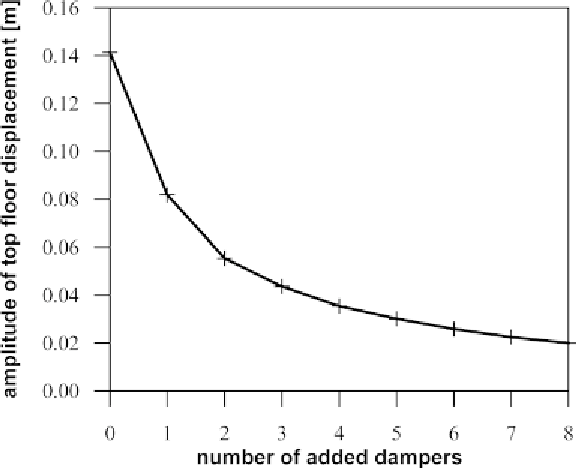Geology Reference
In-Depth Information
Figure 8. Top floor displacement versus number of added dampers
the modulus of the considered transfer function
is calculated for a range of excitation frequencies
which contains the first few natural frequencies
of the structure. The results clearly show that the
maximal value of this function is still at the fun-
damental natural frequency of the structure.
er is located on the first storey of the frame. The
energy dissipated in both damper models is almost
identical to that shown in Figure 7. The horizon-
tal stiffness of the brace is
k
b
=
184 . MN/m
.
The structure is loaded by harmonically varied
displacements of supports, i.e.,
u t
( )
=
U
sin
λ
t
g
g
for
0
≤ ≤
t
.
4 72
sec
and
u t
g
( )
=
0
for
Example 2: A Four-Storey Shear Frame
. m
and
λ
=
6 66. rad/sec
. The equations of motion are
solved with the help of average acceleration ver-
t
>
4 72
.
sec
, where
U
g
=
0 01
As the second example, the four-storey shear
frame analyzed by Singh and Chang (2009) is
considered. The following data are used: the
s t o r e y s t i ff n e s s
k
1
=
. MN/m
,
18 0
Table 4. Logarithmic decrements of damping of
frame with VE dampers
=
. MN/m
,
the floor masses
m m
1
k k
2
= =
. MN/m
,
k
4
12 0
10 0
3
=
=
. Mg
,
40 0
2
= =
. Mg
. The first two non-dimen-
sional damping ratios of frame without dampers,
used to calculate the damping matrix of the frame,
are
γ
m m
3
36 0
Generalized
Kelvin model
Generalized
Maxwell model
4
Logarithmic
decrement of damping
0.178
0.171
= =
.
. The generalized Kelvin and
Maxwell models are used as the VE damper
models. The parameters of both models are twice
as high as the ones shown in Table 3. One damp-
γ
0 02
1
2
Peak value of
displacement [cm]
10.21
10.25
Peak value of
acceleration [m/s
2
]
4.62
4.63































Search WWH ::

Custom Search